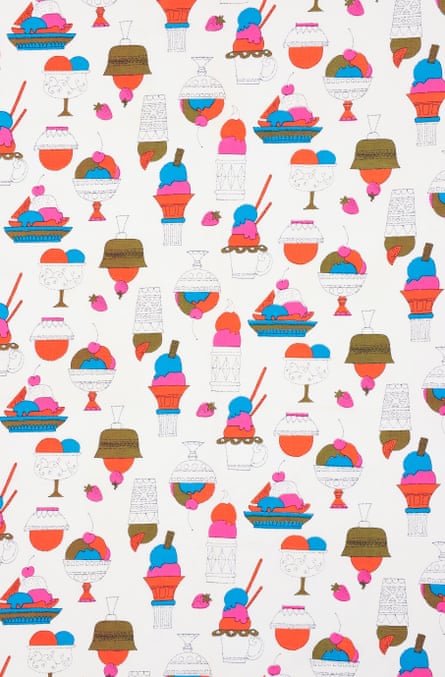In June 2019, a shabby but otherwise unremarkable parcel arrived at the London home of Geoffrey Rayner and Richard Chamberlain. The collectors of 20th-century design had waited months for the package – so long, in fact, that they had almost given up hope of ever receiving the silk dress inside.
The pair’s mission to locate the garment had begun almost a decade before, in the depths of the V&A Museum’s library, where a 60-year-old copy of Glamour magazine alerted them to the design’s existence. In the small print of a four-page article, an image of a dress in the same, distinctive print was credited simply: “Bright Butterflies, designed by Andy Warhol”.
It was only after eight years of online searching, on the website of an obscure vintage store in Albuquerque, New Mexico, that Chamberlain finally laid eyes on the pattern again. “We bought the dress,” he says; its designer wasn’t identified so it was, he pauses before concluding delicately, “keenly priced”.
![Happy Butterfly Day textile, c1955. The dress was made by The Needlecraft [a luxury women’s fashion retailer].](https://i.guim.co.uk/img/media/196f148604cd78bdc3d51e1da3fe42a063477313/21_86_3201_5209/master/3201.jpg?width=445&quality=85&dpr=1&s=none)
While it seems impossible that a painting by Andy Warhol would ever be delivered by post – or transported anywhere without considerable fanfare – the influential pop artist’s textile designs have not commanded the same level of reverence. The artist sold many of his illustrations to textile manufacturers anonymously – a practice that, as Rayner and Chamberlain discovered, now makes them both hard to find and comparatively inexpensive to buy, but which once formed a key part of a successful commercial career.
Beginning with his arrival in New York in 1949, and ending only in 1964 – two years after he painted what is perhaps his most famous work, Marilyn Diptych – Warhol was a popular illustrator of magazines, books, records and textiles. A shrewd businessman, he saw each of these pursuits as a valuable income stream and, Chamberlain says, it was through this work that the artist developed his now-synonymous style.
“This period of his work has been reappraised for many years now, and is seen as an important part of what makes up the whole Warhol picture,” the collector explains. “It is important to see his progression with textile design as something that directly helped inform his early pop art, both in subject matter and approach.”
Rayner and Chamberlain have now curated a new exhibition with London’s Fashion and Textile Museum which, by placing more than 60 of their most significant Warhol textiles on display – many for the very-first time – explores this lesser-known, though clearly meaningful, part of the artist’s career. Much like the discovery of the silk dress, the show has been years in the making, and has involved a great deal of luck, dedication and false starts. “We set up a criterion: his idiosyncratic style, his colouring, his humour,” Chamberlain says of the pair’s early research. The collectors used this formula to track down long-forgotten textiles bearing Warhol’s distinctive faux-naif style illustrations, before setting about authenticating the designs. They trawled archives, sought out textile manufacturers and unearthed records from Warhol’s friends, in order to confirm them as the artist’s work.
Through these years of dedicated research, out the years, Raynor and Chamberlain collected textiles that speak clearly to Warhol’s love of repeat patterns and innate ability to elevate the everyday. In an effort to match the ceremony afforded to the artist’s painted works, their up-coming exhibition will present these fabrics in a simple, darkened space, carefully spotlighting every colourful, carefully illustrated toffee apple, button and tumbling clown. In doing so, the collectors will have succeeded not only in their mission to rediscover Warhols’s textiles, but also in highlighting them as an important facet of the artist’s oeuvre – a key point of development on his road to the Coke bottles and soup cans for which he is best known.
“Above all, the textiles clearly illustrate what a highly individual and talented textile designer Warhol was,” Chamberlain says. “Without us, they probably would have ended up cut up and used for cushions.”
Andy Warhol: The Textiles is at the Fashion and Textile Museum, London, 31 March to 10 September.
after newsletter promotion
Factory offcuts: three more highlights from the exhibition
Acrobatic Clown textile, c1955 (main image)
“The origins of this pattern can be traced back to a group of Christmas cards Warhol designed for Robert MacGregor of New Directions Publishing in 1951. Intended for use as skirts, the design is meant to be read in sequence, with the clown somersaulting from horse to horse.”

Ice Cream Desserts, c1959
“This cotton textile is the earliest in a series of food-related patterns that Warhol designed at the beginning of the 1960s,” says curator Chamberlain. “Other designs included rows of ice-cream cones, interlocking pretzels and giant candy apples.”

Shoes Textile, blouse, Jayson Classics, c1957-58
“The item that Warhol became most synonymous with was the shoe. His many inventive advertising campaigns for footwear company I Miller eventually won him an Art Directors Club award in 1956. A year earlier, Women’s Wear Daily had described him as ‘I Miller’s Da Vinci of shoes’.”

